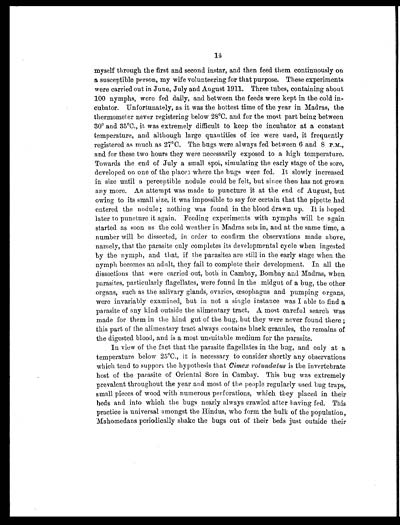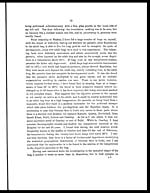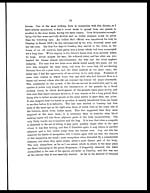Medicine - Institutions > Army health reports and medical documents > Scientific memoirs by officers of the Medical and Sanitary Departments of the Government of India > Number 50 - Preliminary report on an investigation into the etiology of Oriental sore in Cambay > Preliminary report on an investigation into the etiology of Oriental sore in Cambay
(24) Page 14
Download files
Individual page:
Thumbnail gallery: Grid view | List view

14
myself through the first and second instar, and then feed them continuously on
a susceptible person, my wife volunteering for that purpose. These experiments
were carried out in June, July and August 1911. Three tubes, containing about
100 nymphs, were fed daily, and between the feeds were kept in the cold in-
cubator. Unfortunately, as it was the hottest time of the year in Madras, the
thermometer never registering below 28°C. and for the most part being between
30° and 35°C., it was extremely difficult to keep the incubator at a constant
temperature, and although large quantities of ice were used, it frequently
registered as much as 27°C. The bugs were always fed between 6 and 8 P.M.,
and for these two hours they were necessarily exposed to a high temperature.
Towards the end of July a small spot, simulating the early stage of the sore,
developed on one of the places where the bugs were fed. It slowly increased
in size until a perceptible nodule could be felt, but since then has not grown
any more. An attempt was made to puncture it at the end of August, but
owing to its small size, it was impossible to say for certain that the pipette had
entered the nodule; nothing was found in the blood drawn up. It is hoped
later to puncture it again. Feeding experiments with nymphs will be again
started as soon as the cold weather in Madras sets in, and at the same time, a
number will be dissected, in order to confirm the observations made above,
namely, that the parasite only completes its developmental cycle when ingested
by the nymph, and that, if the parasites are still in the early stage when the
nymph becomes an adult, they fail to complete their development. In all the
dissections that were carried out, both in Cambay, Bombay and Madras, when
parasites, particularly flagellates, were found in the midgut of a bug, the other
organs, such as the salivary glands, ovaries, œsophagus and pumping organs,
were invariably examined, but in not a single instance was I able to find a
parasite of any kind outside the alimentary tract. A most careful search was
made for them in the hind gut of the bug, but they were never found there ;
this part of the alimentary tract always contains black granules, the remains of
the digested blood, and is a most unsuitable medium for the parasite.
In view of the fact that the parasite flagellates in the bug, and only at a
temperature below 25°C., it is necessary to consider shortly any observations
which tend to support the hypothesis that Cimex rotundatus is the invertebrate
host of the parasite of Oriental Sore in Cambay. This bug was extremely
prevalent throughout the year and most of the people regularly used bug traps,
small pieces of wood with numerous perforations, which they placed in their
beds and into which the bugs nearly always crawled after having fed. This
practice is universal amongst the Hindus, who form the bulk of the population,
Mahomedans periodically shake the bugs out of their beds just outside their
Set display mode to: Large image | Zoom image | Transcription
Images and transcriptions on this page, including medium image downloads, may be used under the Creative Commons Attribution 4.0 International Licence unless otherwise stated. ![]()
| Permanent URL | https://digital.nls.uk/75061491 |
|---|
| Shelfmark | IP/QB.10 |
|---|---|
| Additional NLS resources: | |




